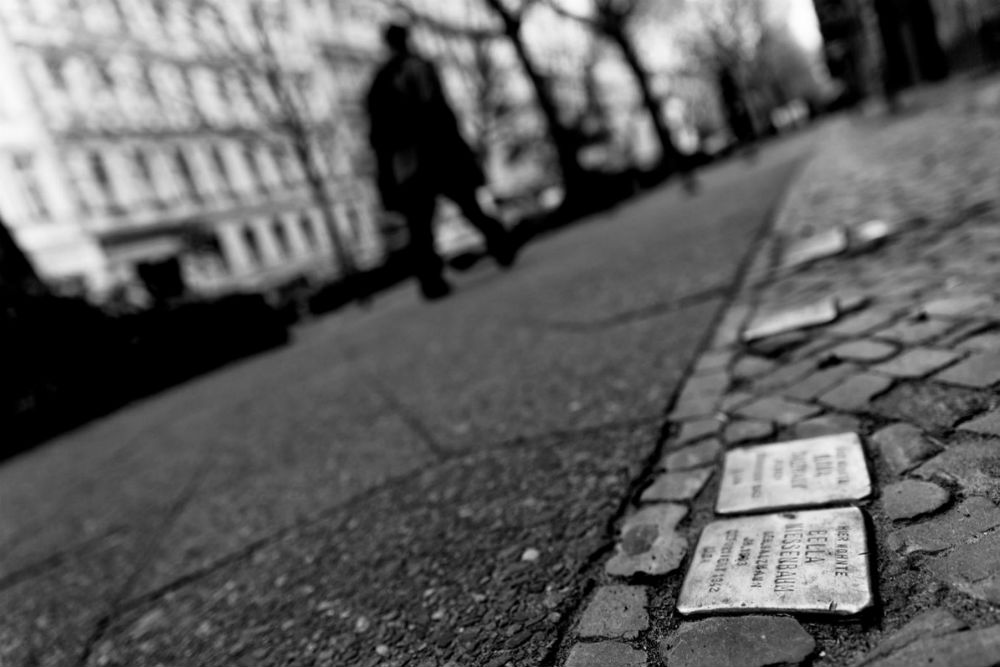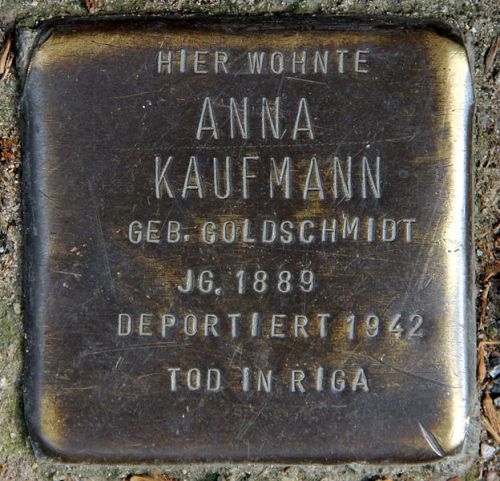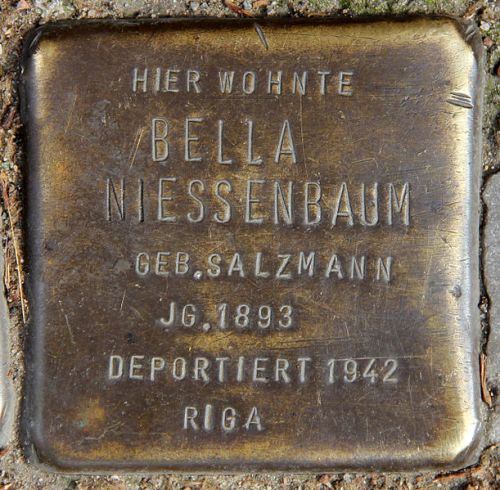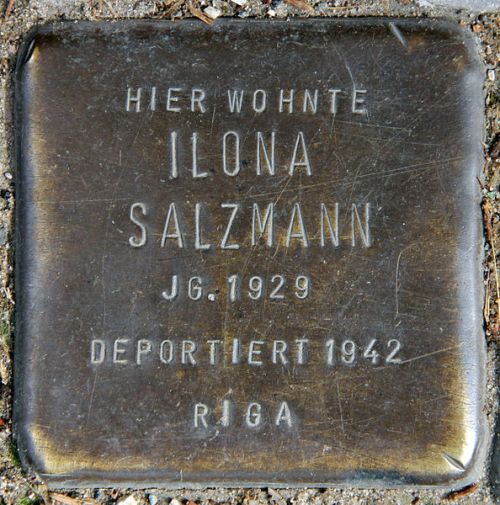Stumbling Stones Dieffenbachstraße 45
These small, brass, memorial plaques (Stolpersteine or stumbling stones) commemorate:
* Rolf Brandt, born 1924, dead in Riga.
* Oskar Kaufmann, born 1879, deported 1942, Riga, ? ? ?
* Anna Kaufmann née Goldschmidt, born 1889, deported 1942, dead in Riga.
* Bella Niessenbaum née Salzmann, born 1893, deported 1942, Riga.
* Ilona Salzmann, born 1929, deported 1942, Riga.
* Max Katz, born 1920, before deportation, committed suicide 06 May 1941.
Anna Goldschmidt first married Martin Brandt (b. 1872); together they had 3 children -- Robert Josef, Lisa Magarete and Rolf Ludwig. Martin Brandt died in 1941. Anna married Oskar Kaufmann on 20 January 1942. Five days later, Anna, Oskar, and her son Rolf Brandt were deported to Riga. Anna and Oskar are considered missing presumably murdered soon after arrival. Rolf Brandt was killed in the Selapsils concentration camp. The other two of Anna’s children – Robert and Lisa – had left Germany in 1939.
No information was found about Bella Niessenbaum, an artisan, and Ilona Salzmann except about their deportations. Both were deported from Berlin on the same transport as the Goldschmidts and Rolf Brandt. (Only 6 or 13 of the over 1,000 people on that transport survived the war.) Bella Niessenbaum was murdered in Riga. The younger Ilona Salzman lived long enough to be deported again, on 9 August 1944, to Stutthof camp. The date of her murder is unknown.
Just before his 21st birthday, Max Katz was driven to suicide by the Nazis. He was buried in Berlin’s Weißensee Cemetery. In 2018, students of the Robert Koch Gymnasium raised funds for a tombstone for his grave.
"Stolpersteine" is an art project for Europe by Gunter Demnig to commemorate victims of National Socialism (Nazism). Stolpersteine (stumbling stones) are small, 10x10cm brass plaques placed in the pavement in front of the last voluntary residence of (mostly Jewish) victims who were murdered by the Nazis. Each plaque is engraved with the victim’s name, date of birth, and place (mostly a concentration camp) and date of death. By doing this, Gunter Demnig gives an individual memorial to each victim. One stone, one name, one person. He cites the Talmud: "A human being is forgotten only when his or her name is forgotten."
Do you have more information about this location? Inform us!
Source
- Text: Fedor de Vries & Anne Palmer
- Photos: Lorie Shaull (1), OTFW, Berlin (2), OTFW, Berlin (3), OTFW, Berlin (4)
- Stolpersteine in Berlin: Anna Kaufmann
- Jüdische Gemeinde zu Berlin: Max Katz
- Stolpersteine.eu
Nearby
Museum
- Bezirksmuseum Friedrichshain-Kreuzberg - Berlin-Kreuzberg
- Jüdisches Museum Berlin (Jewish Museum Berlin) - Berlin
- Luftschutzraum/Dokumentenbunker Tempelhof - Berlin
Point of interest
- Information Panel Destroyed Fraenkelufer Synagogue - Berlijn
- Air-raid Shelter Fichtestraße - Berlin
- Desinfections Anstalt 1 - Berlin
Monument
- Memorial Synagogue Kreuzberg - Berlin-Kreuzberg
- Memorial Attack SA on Jewish Doctors - Berlin-Kreuzberg
- Memorial Benno and Irmgard Heller - Berlin-Neukölln
Cemetery
- Lilienthalstraße German War Cemetery - Berlin
- German War Graves Berlin-Friedrichswerderscher - Berlin
- Garrison Cemetery Columbiadamm - Berlin
Remembrance Stone
- Stumbling Stones Dieffenbachstraße 49 - Berlin-Kreuzberg
- Stumbling Stone Dieffenbachstraße 30 - Berlin-Kreuzberg
- Stumbling Stone Dieffenbachstraße 54 - Berlin-Kreuzberg








